- What Are Personalized Nutrition Guide Apps?
- How Does A Personalized Nutrition Guide App Work?
- Must-Have Features In A Diet And Nutrition App
- Future Trends In Personalised Nutrition Guide App Development
- Mistakes To Avoid In Developing A Personalized Nutrition Guide App
- Tips To Enhance A Personalized Nutrition Guide App
- How Much Does It Cost To Develp A Nutrition Guide App?
- How To Develop A Personalized Nutrition Guide App?
- Top 5 Personalized Nutrition Guide Apps In The Market Right Now
- Tech Stack To Consider To Develop A Personalized Nutrition Guide App
- Conclusion
- How Idea Usher Can Help With Developing A Personalized Nutrition Guide App?
- FAQ
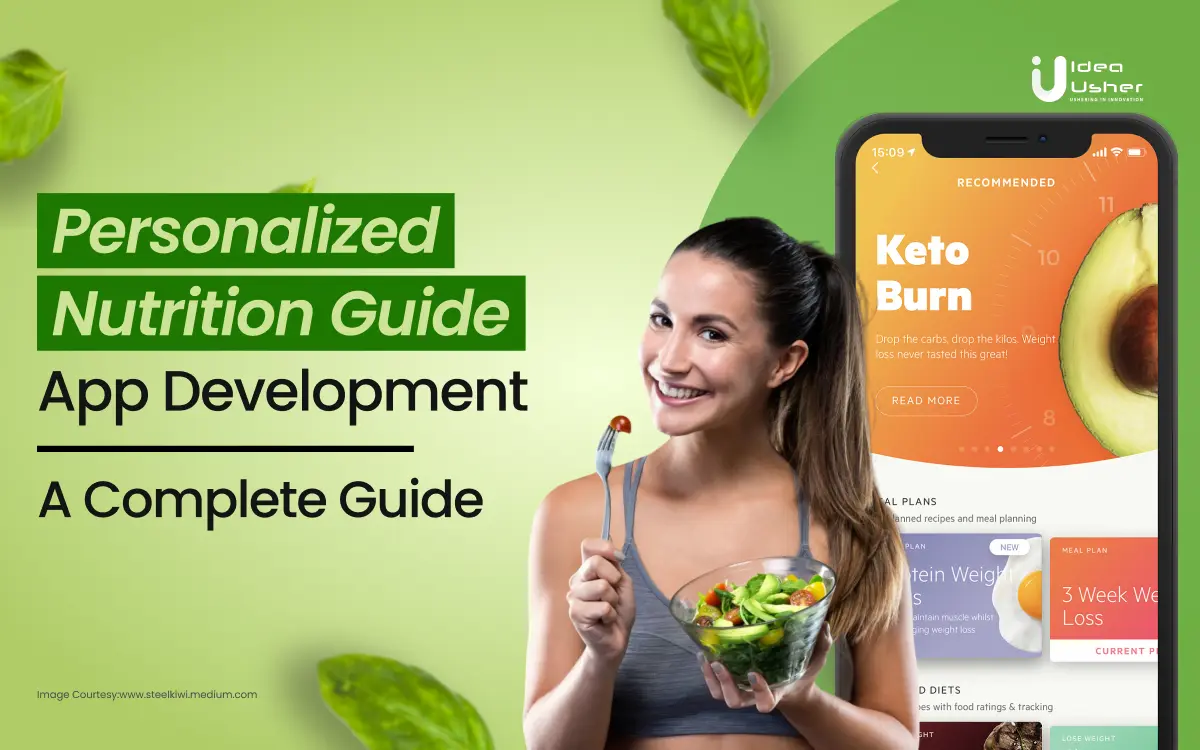
The emergence of nutrition apps is one prominent example of how technological advancements have greatly improved people’s health and well-being. These applications address the difficulty of keeping a balanced diet in today’s fast-paced lifestyles and are backed by scientific research and nutritional experience.
Nutrition apps have become increasingly popular due to the growing trend of mindful eating and the quest for optimal nutrition, particularly with the rising usage of fitness trackers and smartwatches.
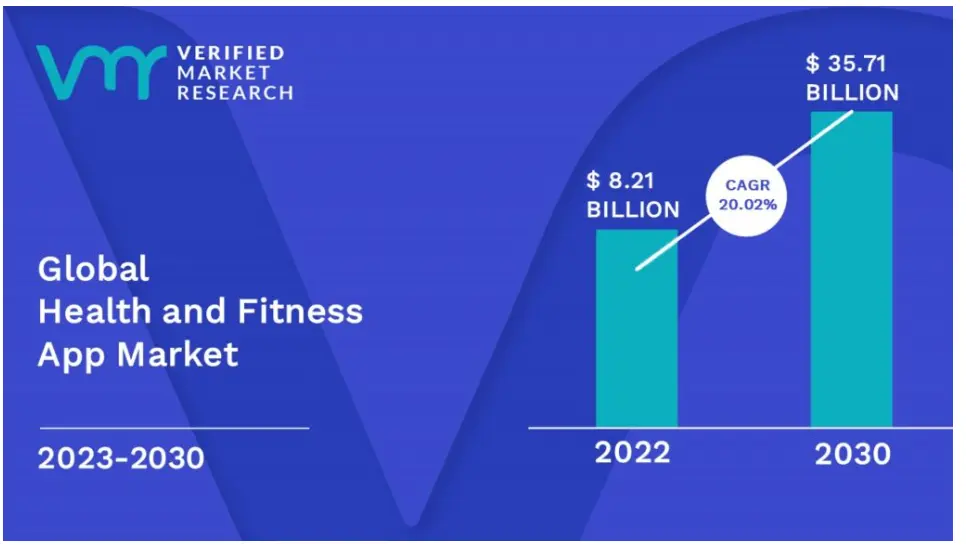
Source: VerifiedMarketResearch
Entrepreneurs looking to tap into this lucrative market should consider incorporating personalized meal planning, real-time nutritional tracking, recipe databases, and integration with wearables or fitness devices.
In this article, we will delve into the personalized nutrition guide app development process and explore the associated costs, providing insights for those considering entering this thriving market.
- What Are Personalized Nutrition Guide Apps?
- How Does A Personalized Nutrition Guide App Work?
- Must-Have Features In A Diet And Nutrition App
- Future Trends In Personalised Nutrition Guide App Development
- Mistakes To Avoid In Developing A Personalized Nutrition Guide App
- Tips To Enhance A Personalized Nutrition Guide App
- How Much Does It Cost To Develp A Nutrition Guide App?
- How To Develop A Personalized Nutrition Guide App?
- Top 5 Personalized Nutrition Guide Apps In The Market Right Now
- Tech Stack To Consider To Develop A Personalized Nutrition Guide App
- Conclusion
- How Idea Usher Can Help With Developing A Personalized Nutrition Guide App?
- FAQ
What Are Personalized Nutrition Guide Apps?
Personalized nutrition guide apps enable users to track their diet and workout routines while providing tailored suggestions for healthier eating. These apps cater to individuals seeking to improve their overall well-being, as well as medical professionals or nutritionists offering personalized plans to clients.
The increasing awareness of the importance of healthy nutrition and exercise has fueled the demand for these apps. They offer users a convenient and effective way to monitor their progress and make informed decisions about their nutrition and diet. The success of these apps lies in their ability to provide personalized advice based on individual requirements and preferences, considering factors such as weight, age, and activity level.
By analyzing user data, these apps generate customized meal plans and exercise routines, aligning with the specific needs of each individual. Features like calorie counters, nutrient trackers, and exercise logs contribute to a comprehensive overview of users’ fitness and health goals. This allows users to stay on top of their progress and maintain a holistic view of their overall health and well-being.
Apps focused on healthy diet and exercise are essential for promoting positive lifestyle choices and physical activity. As more people seek straightforward yet efficient solutions to enhance their general health, the popularity of these apps is expected to continue rising.
How Does A Personalized Nutrition Guide App Work?
A Personalized Nutrition Guide App uses information about an individual’s health, dietary preferences, lifestyle, and other relevant factors to provide customized advice and recommendations for optimal nutrition. Here’s a general overview of how such an app might work:
1. User Profile Creation
When users start creating their profiles, the app can employ interactive interfaces and intuitive design to ensure a seamless onboarding experience. Detailed questionnaires may cover basic information like age and weight and delve into the user’s cultural background, culinary preferences, and even psychological factors related to their relationship with food. Advanced apps may incorporate biofeedback technologies to measure stress levels or emotional states, providing a more holistic understanding of the user.
2. Health Assessment
The health assessment phase could involve collaborations with health professionals, where the app connects users with dietitians or nutritionists for virtual consultations. These professionals could provide additional insights, helping users set realistic health goals and understand the importance of specific dietary changes. The app might also use gamification elements to engage users in the assessment process, making it more enjoyable and encouraging active participation.
3. Data Integration
The app’s integration with wearable devices goes beyond basic fitness tracking. It might utilize advanced sensors to measure bioindicators such as blood glucose levels or nutrient deficiencies. This real-time data could be visualized in user-friendly dashboards, empowering individuals to make immediate, informed decisions about their nutrition and lifestyle. The app could also collaborate with other health-related apps, fostering a holistic approach to well-being.
4. Nutritional Database
The nutritional database, a cornerstone of the app, should be regularly updated with the latest scientific research on food and nutrition. Machine learning algorithms can help predict emerging nutritional trends and adjust the database accordingly. The app might also incorporate augmented reality features, allowing users to scan products in grocery stores to instantly access detailed nutritional information and make informed choices on the spot.
5. Algorithms and Machine Learning
To enhance personalization, the app’s algorithms could factor in genetic information. Integrating genomic data may offer insights into an individual’s predisposition to certain health conditions or nutritional needs. Machine learning models should continuously refine themselves based on user feedback and evolving health trends. Explainable AI features can also help users understand the rationale behind specific recommendations, fostering trust in the app’s guidance.
6. Meal Planning
The app’s meal planning feature should not only consider nutritional needs but also accommodate cultural and social aspects of eating. It might offer collaborative meal planning options, allowing users to create shared meal plans for families or groups. Dynamic adjustments to meal plans based on user feedback, seasonal changes, or local food availability can further enhance the app’s adaptability.
7. Recipe Suggestions
Beyond providing recipes, the app could facilitate community-driven content, where users share their favorite recipes and experiences. Advanced features might include recipe customization tools that allow users to tweak recipes based on their dietary preferences and ingredient availability. Integration with grocery delivery services could streamline the process of acquiring ingredients, making healthy eating more convenient.
8. Nutrient Tracking
Nutrient tracking could extend beyond traditional metrics, incorporating personalized biomarker tracking. The app might use data from wearable health devices to monitor indicators like vitamin D levels or inflammatory markers. Visualization tools could present this data in a user-friendly format, empowering individuals to correlate their dietary choices with specific health outcomes.
9. Progress Monitoring
n addition to conventional progress metrics like weight and body mass index (BMI), the app could incorporate subjective well-being assessments. Users might regularly answer questions related to energy levels, mood, and sleep quality. This qualitative data, combined with quantitative metrics, provides a more comprehensive picture of the user’s overall health and progress.
10. Adaptation and Feedback
User feedback mechanisms should be robust, allowing users to provide nuanced insights into their experiences. The app could leverage natural language processing to analyze user comments and extract valuable information. Regular surveys or quizzes may gauge user satisfaction and capture evolving preferences, enabling continuous refinement of the app’s recommendations.
11. Notifications and Reminders
Personalization is key in the delivery of notifications. The app could learn from user behavior, adapting the timing and content of notifications based on when users are most receptive. Incorporating behavioral science principles, such as positive reinforcement and habit formation, can contribute to the effectiveness of reminders and nudges.
Must-Have Features In A Diet And Nutrition App
Explore essential features that make a nutrition guide app effective and user-friendly, ensuring users have the tools they need to achieve their nutritional goals seamlessly
1. Tailored Meal Plans
In a comprehensive diet and nutrition app, the inclusion of individualized meal plans is crucial for catering to the unique needs and goals of users. To enhance personalization, users should be able to input information such as height, age, and weight. This data is then utilized to generate personalized meal plans that align with their specific dietary requirements and objectives. The meal plans should not only focus on calorie count but also take into account the distribution of macronutrients (proteins, fats, and carbohydrates) and micronutrients, ensuring a well-balanced approach to nutrition.
2. Nutritional Diary
A user-friendly food diary is an indispensable tool for individuals aiming to monitor their daily dietary intake efficiently. The app should provide a seamless and quick way for users to log their meals and snacks throughout the day. Furthermore, the food diary should go beyond just calorie tracking; it should also present detailed information on macronutrients and micronutrients consumed. This comprehensive approach empowers users to make informed decisions about their nutritional choices, fostering a greater understanding of their dietary habits.
3. Barcode Scanning Functionality
The integration of a barcode scanner within the app enhances user convenience by providing a swift and accurate method for accessing nutritional information from packaged food items. This feature not only saves time but also reduces the effort required for manual data entry. By simply scanning the barcode of a product, users can access a detailed breakdown of its nutritional values, enabling them to make informed choices aligned with their dietary goals. This functionality promotes efficiency and accuracy in tracking daily nutritional intake.
4. Hydration Monitoring Tool
Recognizing the vital role of hydration in overall health, a diet and nutrition app should incorporate a dedicated drinking water tracker. This feature allows users to monitor their daily water consumption, ensuring they maintain adequate hydration levels. The app can provide reminders and personalized goals to encourage users to stay hydrated throughout the day. By fostering awareness of water intake, this tracker contributes to users’ overall well-being and supports their commitment to a healthy lifestyle.
5. Exercise Tracker
To promote holistic health and aid users in achieving their fitness objectives, a diet and nutrition app should include a robust exercise tracker. This feature enables users to record their exercise routines and track their progress over time. Incorporating safety measures, such as guidance on proper form and intensity, ensures that users engage in physical activities effectively. The exercise tracker complements the nutritional aspect of the app, creating a comprehensive platform for users to manage both diet and fitness seamlessly.
6. Innovative Recipe Building Tool
Empowering users to maintain healthy eating habits, a recipe builder feature allows individuals to create nutritious dishes using ingredients they already have. This feature encourages creativity in meal planning while adhering to the principles of a balanced diet. Users can experiment with different combinations of ingredients, ensuring variety in their meals while staying within their dietary goals. The recipe builder enhances the app’s versatility, making it a valuable tool for users who seek not only guidance but also flexibility in their nutritional choices.
7. Nutritional Information
Accurate and accessible nutritional data is a key component of a successful diet and nutrition app. Users should be able to swiftly retrieve detailed information about specific food items, including calorie counts and the breakdown of macronutrients and micronutrients. This feature aids users in making informed decisions about their food choices, promoting a greater understanding of the nutritional content of different foods. Providing a comprehensive database of nutritional information enhances the app’s usability and reliability, ensuring that users have the necessary information to align their dietary intake with their health and wellness goals.
Future Trends In Personalised Nutrition Guide App Development
Explore the emerging trends that will shape the next generation of diet and nutrition app development, revolutionizing how we approach and personalize our dietary choices.
1. Personalization in Diet and Nutrition Apps
Personalization is at the forefront of diet and nutrition app development as developers recognize the diverse needs and preferences of users. In addition to the basic factors like age, gender, and weight, advanced apps are integrating more personalized data such as genetic information and blood markers. These apps use this data to create tailored meal plans, taking into account individual nutritional requirements, allergies, and dietary restrictions.
Moreover, the trend extends beyond meal planning to include personalized workout recommendations and lifestyle adjustments. AI algorithms are employed to continuously analyze user data, adapting recommendations based on progress and changes in health goals. The emphasis is on creating a holistic and personalized experience, ensuring users are more likely to stick to their nutrition plans and achieve long-term health objectives.
2. Integration of Wearable Devices
The integration of wearable devices into diet and nutrition apps is evolving to provide more real-time and accurate data. Apps now sync seamlessly with smartwatches and fitness trackers to gather information such as heart rate, sleep patterns, and physical activity levels. This data is then used to refine dietary recommendations, adjusting meal plans and calorie targets based on the user’s daily activity.
Furthermore, some apps leverage biometric data from wearables to assess stress levels and emotional well-being, factors that can significantly impact dietary habits. This comprehensive approach not only enhances the accuracy of nutritional guidance but also contributes to a more holistic understanding of the user’s overall health.
3. Gamification for User Engagement
Gamification has proven to be a powerful tool for user engagement in diet and nutrition apps. Beyond the basic tracking of food intake and exercise, apps now incorporate game-like elements such as challenges, rewards, and badges. Users are motivated to achieve specific nutritional milestones, with rewards ranging from virtual badges to discounts on health-related products or services.
In addition, some apps introduce social competition, allowing users to challenge friends or join community challenges. This fosters a sense of community and accountability, making the journey towards a healthier diet more enjoyable and sustainable. The gamification trend not only appeals to those seeking a more interactive experience but also serves as a motivational tool for users at various stages of their health and wellness journey.
4. Artificial Intelligence for Smart Nutrition Recommendations
Artificial intelligence is revolutionizing diet and nutrition apps by offering advanced analytical capabilities. AI algorithms analyze users’ food consumption patterns, identifying trends and making personalized recommendations for healthier food choices. This goes beyond simple calorie counting, taking into account nutritional value, food combinations, and even meal timing.
Machine learning algorithms continually refine recommendations based on user feedback and outcomes, ensuring a dynamic and adaptive approach to personalized nutrition. Some apps also leverage image recognition technology, allowing users to snap pictures of their meals for instant nutritional analysis. As AI continues to advance, the potential for highly accurate and tailored dietary advice becomes increasingly promising.
5. Social Features for Community Building
Nutrition and diet apps are embracing social features to create a sense of community among users. Beyond basic forums, apps now facilitate social connections through features like recipe sharing, group challenges, and collaborative goal setting. Users can share their success stories, exchange tips, and provide support during challenging times.
In addition, some apps leverage social connections to enhance accountability, allowing users to connect with friends, family, or even nutrition professionals for added guidance. The community-driven approach not only provides emotional support but also fosters a collaborative environment where users can learn from each other’s experiences and celebrate collective achievements.
6. Virtual Coaching for Personalized Guidance
Virtual coaching is emerging as a key component of diet and nutrition apps, offering users personalized guidance and support. Beyond pre-programmed advice, virtual coaching integrates real-time interactions with dietitian-nutritionists. Users can schedule virtual sessions, receiving customized advice based on their unique needs and goals.
Moreover, 24/7 chatbot support is becoming increasingly sophisticated, providing instant responses to user queries. These chatbots not only offer quick answers but also contribute to ongoing support, reminding users of their goals, providing motivation, and offering real-time feedback on dietary choices. The virtual coaching trend aims to make professional guidance more accessible and convenient, bridging the gap between users and nutrition experts.
Mistakes To Avoid In Developing A Personalized Nutrition Guide App
In this section, we’ll explore key mistakes to steer clear of during the development process which can help you enhance the effectiveness and user experience of your diet and nutrition app.
1. Complex User Interface
When embarking on diet and nutrition app development, it’s crucial to prioritize a clean, simple, and intuitive user interface (UI). Overcomplicating the UI can be a significant deterrent to user engagement. Users, especially those new to nutrition tracking, may feel overwhelmed and frustrated if they encounter a cluttered design. Keep in mind that the primary goal is to facilitate easy navigation and encourage regular app usage.
Consider incorporating visual elements like icons and graphics to make the app visually appealing and user-friendly. Group related features logically and avoid unnecessary complexities. Conduct user testing to gather feedback on the app’s usability and make adjustments accordingly.
2. Minimal Personalization
Avoid adopting a one-size-fits-all approach in your diet and nutrition app. Users have diverse dietary needs, preferences, and goals. Incorporate features that allow users to personalize their diet plans based on factors such as dietary restrictions, fitness levels, and health objectives.
Consider integrating machine learning algorithms that analyze user data to provide personalized recommendations. This personalization not only enhances user satisfaction but also increases the app’s effectiveness in helping users achieve their health and fitness goals.
3. Inaccurate Nutritional Information
The backbone of any diet and nutrition app is its food database and nutritional information. Providing inaccurate or outdated data can undermine the credibility of the app and compromise user trust. Collaborate with nutrition professionals, dietitians, and utilize reliable sources for nutritional information.
Implement a system for regular updates to ensure that the app reflects the latest nutritional data. Establish partnerships with reputable food databases or nutrition organizations to access accurate and up-to-date information. Transparency about data sources within the app can also enhance user trust.
4. No Data Security
Ensuring the security of user data is paramount. A breach in data security can lead to severe consequences, including loss of user trust and potential legal issues. Implement robust encryption protocols to safeguard sensitive user information.
Regularly update security measures to stay ahead of potential threats. Clearly communicate the security features to users, assuring them that their data is in safe hands. Compliance with data protection regulations, such as GDPR or HIPAA, depending on the app’s scope, is essential for maintaining trustworthiness.
5. Lack of Integration and Compatibility
To maximize your app’s reach, ensure compatibility with various devices and operating systems. Integration with other health and fitness apps, wearables, or smart devices can provide a seamless user experience.
Consider partnerships or API integrations with popular fitness trackers or smartwatches. This not only expands your app’s user base but also enhances its functionality by leveraging data from other health-related sources.
6. Ignoring User Reviews and Feedback
User feedback and reviews provide valuable insights into user experiences and areas for improvement. Ignoring this feedback is a missed opportunity to enhance the app’s functionality and user satisfaction.
Establish a system for actively monitoring user feedback, both positive and negative. Address issues promptly, and consider incorporating user suggestions into future updates. Engaging with users through feedback channels can foster a sense of community and loyalty.
7. Unrealistic Claims or Promises
Honesty is key when marketing a diet and nutrition app. Avoid making unrealistic claims or promises about the app’s ability to achieve specific health outcomes. Instead, focus on providing evidence-based information and setting realistic expectations for users.
Clearly communicate the app’s features and limitations. Providing educational content within the app about nutrition and fitness can help users understand the principles behind their dietary choices, promoting a more informed and sustainable approach to health.
8. Ignoring User Engagement
User engagement is vital for the success of any diet and nutrition app. Merely providing tracking and logging features may not be enough to keep users motivated. Integrate interactive elements, challenges, and notifications to maintain user interest.
Consider implementing a social component where users can connect, share achievements, and support each other. Regularly update the app with new challenges or features to keep the experience fresh and exciting. Gamification techniques, such as earning badges or rewards for milestones, can also boost engagement.
Tips To Enhance A Personalized Nutrition Guide App
From cutting-edge AI integration to fostering a supportive community, add the following things to your app to enhance your app experience
1. Integrating Wearable Devices
In addition to tracking physical activity, heart rate, and sleep patterns, integrating with wearable devices allows the app to offer real-time, context-aware recommendations. For example, if the user completes an intense workout, the app can suggest a post-exercise nutrition plan to optimize recovery. Moreover, leveraging the GPS capabilities of these devices can provide location-based nutrition suggestions, considering factors like local food options and weather conditions. This integration not only enhances personalization but also creates a seamless and holistic user experience by consolidating health data in one place.
2. Artificial Intelligence
AI algorithms play a pivotal role in deciphering complex data sets to provide meaningful insights and suggestions. Beyond meal recommendations, AI can analyze historical user data to predict future trends in eating habits, helping users anticipate challenges and plan accordingly. Moreover, integrating machine learning models enables the app to adapt and refine its suggestions over time, aligning with the user’s evolving preferences and lifestyle changes. AI-driven features can also assist in identifying potential allergies or intolerances based on consumption patterns, ensuring a more tailored and safe user experience.
3. Gamification Design
Gamification goes beyond traditional goal-setting by infusing elements of competition and achievement into the user’s health journey. Implementing leaderboards, virtual challenges, and collaborative missions fosters a sense of camaraderie among users. Additionally, awarding virtual badges for milestones achieved can serve as a powerful motivator, reinforcing positive behaviors and creating a fun and interactive environment. The app can also leverage user data to create personalized challenges, ensuring that goals are challenging yet achievable, further enhancing user satisfaction and retention.
4. Develop Social Communication Features
The incorporation of social communication features transforms the app into a community hub where users can share their achievements, challenges, and recipes. Implementing group challenges or collaborative cooking sessions fosters a sense of accountability and support. The app can also facilitate direct messaging or video calls among users, enabling real-time interaction and advice-sharing. User-generated content, such as success stories and healthy recipes, can be showcased, creating an inspiring and inclusive environment that strengthens the user-community bond.
5. Testing and Analyzing Feedback
Regularly testing the app involves not only technical evaluations but also usability studies to ensure an intuitive and user-friendly interface. User feedback can be solicited through in-app surveys, and beta testing programs, allowing developers to identify pain points and areas for improvement. Continuous monitoring of app performance, including loading times and responsiveness, ensures a smooth user experience. Analyzing feedback should not only focus on bug fixes but also on understanding user preferences, allowing for iterative updates that align with evolving user needs and expectations. Regularly updating the app based on user feedback demonstrates a commitment to continuous improvement and user satisfaction.
How Much Does It Cost To Develp A Nutrition Guide App?
The cost of developing a nutrition guide app can vary significantly based on several factors. Here are few considerations that influence the overall cost:
1. Features and Complexity
The breadth and complexity of features play a crucial role in determining the cost of development. Basic apps with essential features such as user profiles, meal tracking, and recipe suggestions may have a lower cost. On the other hand, apps incorporating advanced functionalities like real-time data integration with wearables, personalized algorithms, or augmented reality features will require more development effort and, consequently, a higher budget.
2. Platform (iOS, Android, Cross-Platform)
The choice of platforms significantly impacts development costs. Developing separate versions for iOS and Android generally requires more resources than creating a cross-platform app. Cross-platform development tools like React Native or Flutter can provide cost savings by allowing developers to write code that works on both platforms.
3. Design and User Interface (UI/UX)
A visually appealing and user-friendly design is crucial for the success of a nutrition guide app. The complexity of the design, the need for custom graphics, animations, and the level of detail in the user interface can all contribute to costs. Investing in a professional UI/UX design can enhance user engagement but may incur additional expenses.
4. Integration with External APIs and Devices
If the app is designed to integrate with external APIs for real-time nutritional data or wearable devices for health tracking, the complexity and cost of development will increase. Implementing secure and seamless integrations with various APIs and devices requires additional programming effort.
5. Data Security and Compliance
Nutrition guide apps often deal with sensitive user information, including health data. Ensuring robust data security measures and compliance with regulations such as HIPAA (Health Insurance Portability and Accountability Act) can add complexity to the development process. The inclusion of encryption, secure data storage, and adherence to privacy standards may increase development costs.
6. Content and Database
The richness of the app’s content, such as an extensive nutritional database, recipe library, and multimedia content, can impact development costs. Building and maintaining a comprehensive nutritional database or licensing content from reliable sources may involve additional expenses. The scalability of the database architecture to handle growing user data should also be considered.
7. Testing and Quality Assurance
Thorough testing is essential to ensure the app’s functionality, usability, and security. The complexity of the app, the number of features, and the need for compatibility testing across various devices and operating system versions influence testing efforts. Investing in comprehensive quality assurance processes helps identify and address issues early in the development cycle but can contribute to higher costs.
How To Develop A Personalized Nutrition Guide App?
Creating a personalized nutrition guide app involves several specific steps that cater to the unique aspects of such an application. Here’s a guide to help you develop a personalized nutrition guide app:
1. Define Your Target Audience
Identifying the specific demographic you aim to serve is crucial for tailoring your personalized nutrition app. Conduct thorough market research to understand the unique needs, preferences, and challenges of your target audience. This insight will guide the customization of features and content to address the specific goals and interests of the identified demographic. By creating user personas, you can ensure that the app resonates with the diverse individuals within your chosen target audience.
2. Research Nutritional Guidelines
Collaborate with nutritionists, dietitians, or health experts to gather up-to-date and accurate nutritional information. It is essential to stay informed about the latest research and developments in nutritional science. This ensures that the app’s guidelines align with established health standards and recommendations. Providing references or citations for nutritional information enhances the credibility of your app. Consider adapting guidelines based on user feedback and emerging nutritional trends to maintain relevance.
3. User Profile Creation
Develop a comprehensive user profile system that captures essential information for personalized recommendations. Include parameters such as age, weight, height, activity level, dietary preferences, and health conditions. Allow users to update their profiles regularly to accommodate changes in lifestyle or health status. Ensure data privacy by implementing secure authentication and authorization processes. Enable users to set and modify their health and fitness goals within the profile, fostering a sense of ownership.
4. Integration of Wearable Devices
Establish seamless integration with popular wearable devices to collect real-time health and activity data. This integration can encompass metrics such as steps taken, calories burned, sleep patterns, and heart rate, enhancing personalization. Provide users with insights derived from wearable data to further refine nutritional recommendations. Ensure compatibility with a variety of wearable devices to cater to diverse user preferences. Communicate the benefits of wearable integration to users, promoting increased engagement and a holistic health approach.
5. Machine Learning Algorithms
Implement machine learning algorithms to analyze user data and generate personalized nutritional recommendations. These algorithms should be designed to adapt and improve based on user feedback and evolving health information. Consider incorporating collaborative filtering techniques to offer recommendations based on user similarities, fostering a sense of individualization. Communicate the underlying principles of the algorithms to users for transparency and trust. Regularly update algorithms to incorporate advancements in machine learning and nutritional science, ensuring the app’s efficacy.
6. Food Database Integration
Build or integrate a comprehensive and up-to-date food database with accurate nutritional information. Include a wide variety of foods, accounting for different cuisines, preparation methods, and serving sizes. Implement a user-friendly search and logging system to make food tracking convenient for users. Allow users to contribute to the database by submitting new foods or verifying existing entries, promoting a collaborative and inclusive approach. Regularly update the food database to reflect new products and changes in nutritional content, ensuring accuracy.
7. Meal Planning Feature
Develop an intuitive meal planning feature that considers users’ nutritional requirements and dietary preferences. Provide a variety of meal options, including breakfast, lunch, dinner, and snacks, catering to diverse eating habits. Incorporate a drag-and-drop interface for easy customization of meal plans, empowering users to personalize their dietary choices. Include features for batch cooking and meal prep to save time and promote consistency in adherence to nutritional plans. Enable users to set reminders for meal times, facilitating adherence to their personalized plans and promoting healthy habits.
8. Recipe Suggestions and Customization
Offer a diverse range of recipes that align with users’ nutritional needs and dietary preferences. Include filters for dietary restrictions, allergens, and cuisine preferences in recipe suggestions. Implement a rating and review system for recipes to guide users in selecting tried-and-true options. Allow users to customize recipes based on available ingredients or personal taste preferences, fostering a sense of autonomy. Integrate a shopping list feature that automatically compiles ingredients from selected recipes, simplifying the preparation process.
9. Allergen and Dietary Restriction Alerts
Implement alerts and notifications for potential allergens or dietary restrictions based on user profiles. Provide detailed information on the specific ingredients or nutrients that may pose a concern, enhancing user awareness. Include an option for users to input additional allergies or restrictions not covered in the initial profile, ensuring a comprehensive alert system. Ensure that alerts are prominently displayed within the app and through push notifications, prioritizing user safety. Allow users to customize the sensitivity of alerts based on their individual needs, promoting a personalized experience.
10. Progress Tracking and Analytics
Develop an intuitive dashboard that allows users to track their progress over time, providing a visual representation of achievements. Include charts and graphs to illustrate changes in weight, body composition, or other relevant health metrics, promoting transparency. Provide insights and explanations for fluctuations or trends observed in the user’s data, enhancing user understanding. Implement a goal-setting feature to help users stay motivated and focused on their health objectives. Allow users to export or share their progress reports with healthcare professionals if desired, fostering collaboration in achieving health goals.
11. Educational Content
Create a comprehensive library of educational content on nutrition, health, and wellness. Offer articles, videos, and interactive modules to cater to various learning preferences, promoting user engagement. Break down complex nutritional concepts into easily digestible and user-friendly content, enhancing comprehension. Integrate tooltips or pop-ups within the app to explain the rationale behind specific recommendations, fostering informed decision-making. Encourage users to engage with educational content to foster a deeper understanding of their nutritional choices, empowering them to make informed decisions.
12. Integration with Health Professionals
Implement features that enable users to share their data securely with healthcare professionals or nutritionists. Ensure compliance with privacy regulations and obtain explicit user consent for data sharing, prioritizing user privacy. Facilitate communication channels for users to receive personalized advice or feedback from health professionals, promoting a collaborative approach to health management. Consider a telehealth integration for virtual consultations or follow-ups, providing users with convenient access to professional guidance. Provide resources or tools to help healthcare professionals interpret and utilize user-generated data effectively, enhancing the value of the app in a healthcare context.
13. User Engagement and Motivation
Implement a notification system to remind users of upcoming meals, workouts, or progress milestones, fostering adherence to personalized plans. Integrate a rewards system to acknowledge and celebrate user achievements, promoting a positive and motivating experience. Incorporate a social aspect, such as a community forum or social media integration, for users to share tips, recipes, and success stories, building a sense of community. Use gamification elements, such as challenges or badges, to keep users engaged and motivated. Solicit user feedback regularly to identify areas for improvement and enhance overall user satisfaction, ensuring ongoing engagement.
14. Privacy and Security
Prioritize data privacy by implementing robust encryption protocols and secure data storage, instilling user trust. Clearly communicate your app’s privacy policy and terms of use to users, fostering transparency. Obtain explicit consent for data collection and sharing during the onboarding process, respecting user autonomy. Regularly audit and update security measures to address emerging threats, ensuring the ongoing protection of user data. Comply with relevant data protection regulations, such as GDPR or HIPAA, depending on the nature of the app and the user data collected, establishing a commitment to regulatory compliance.
15. Continuous Improvement
Establish a feedback loop with users through surveys, reviews, and user analytics, demonstrating a commitment to user satisfaction. Regularly update the app based on user feedback, technological advancements, and emerging nutritional research, ensuring relevance. Monitor trends in health and wellness to incorporate relevant features or recommendations, staying ahead of user expectations.
Top 5 Personalized Nutrition Guide Apps In The Market Right Now
Explore the top five nutrition guide apps currently making waves in the market, each offering unique features to support a balanced and informed approach to nutrition and well-being.
1. MyFitnessPal
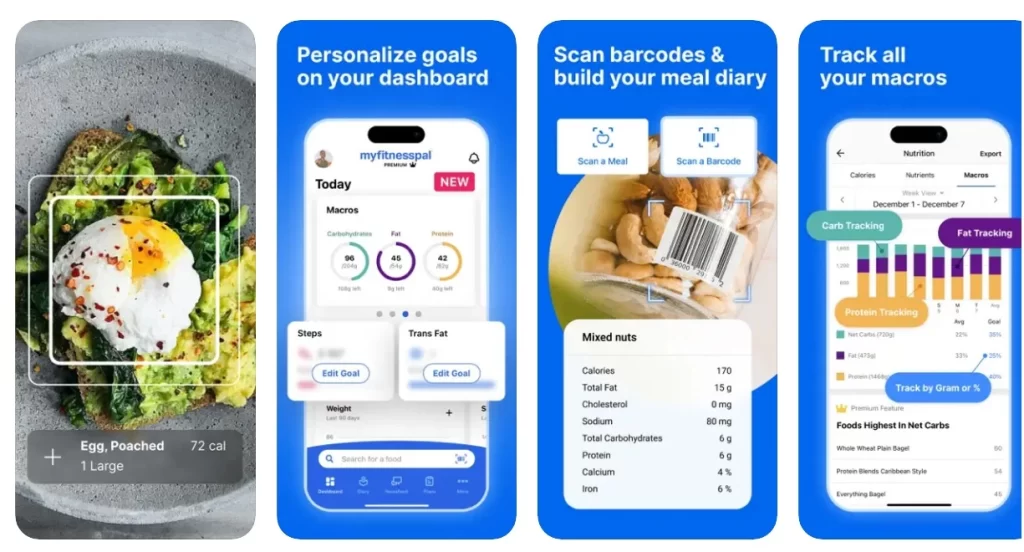
MyFitnessPal remains a top contender among food and fitness tracking apps, boasting a colossal food database with over 14 million items. It simplifies the process with easy data entry for daily food intake, calculating essential nutrients like protein, fat, and carbs. Users can conveniently copy and paste previously logged meals and import recipes from various sources. With menu details from popular restaurants, tracking becomes seamless. While a free version offers many features, a premium membership adds benefits like VIP support, an ad-free experience, and a barcode scanner, though user-added data may result in occasional inaccuracies.
2. Weight Watchers
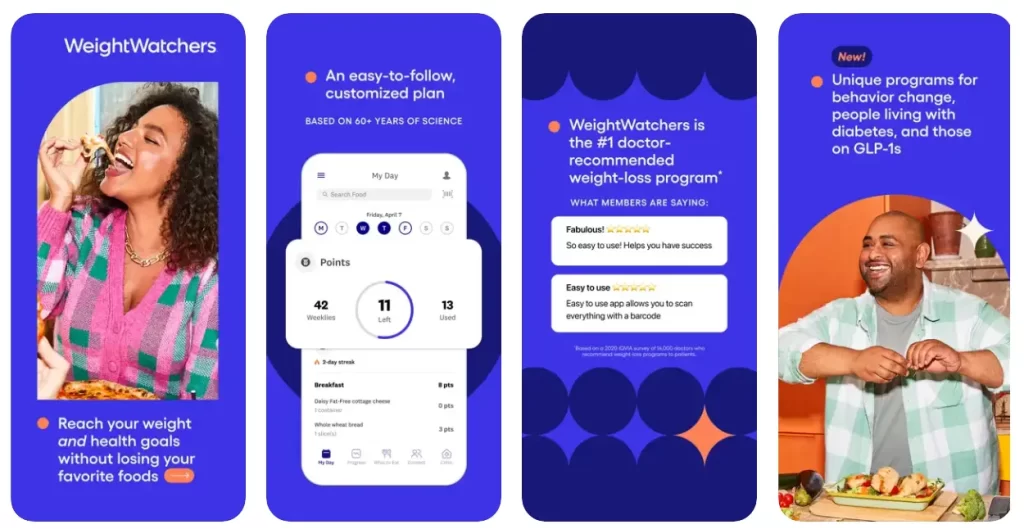
Formerly known as Weight Watchers, WW presents an extensive food database, simplifying tracking by allowing users to input specific brands and restaurant meals. The app calculates nutritional breakdowns, tracks activity, monitors water intake, and even oversees sleep. Offering over 4,000 recipes, multiple filters, and barcode scanning, WW encourages easy tracking of daily meals and popular items. Subscriptions are required, and costs may vary, but the app frequently provides discounts, and corporate discounts are also available.
3. MyNetDiary
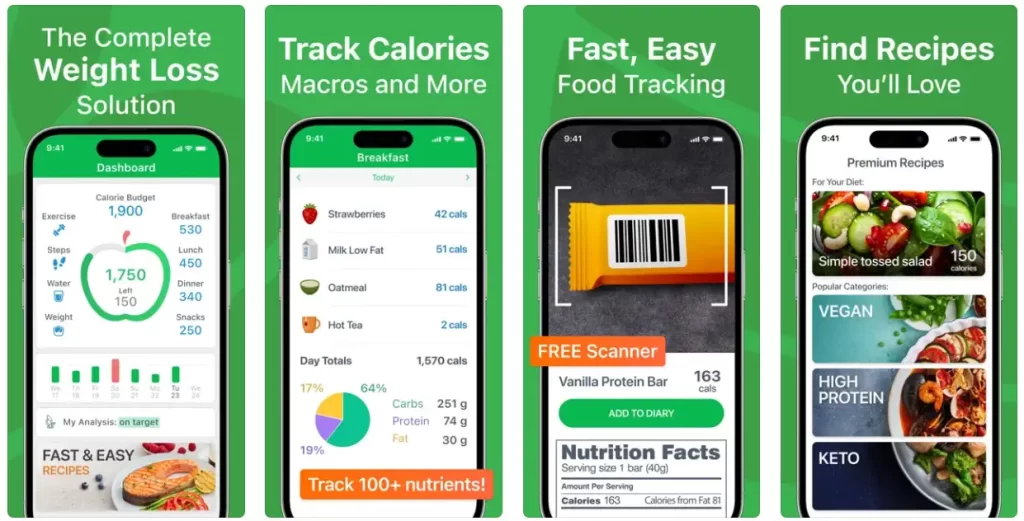
MyNetDiary excels with its large food database and user-friendly interface. After assessing weight, height, and age, the app sets weekly weight goals. Users praise it for promoting balanced meals, proper portion sizes, and monitoring sodium and saturated fat intake. The free version contains ads, but upgrading to the premium ad-free option provides additional features like macronutrient percentage charts and access to recipes tailored to various dietary needs. The free barcode scanner enhances food tracking by pulling in data and calculating nutrition.
4. Cronometer
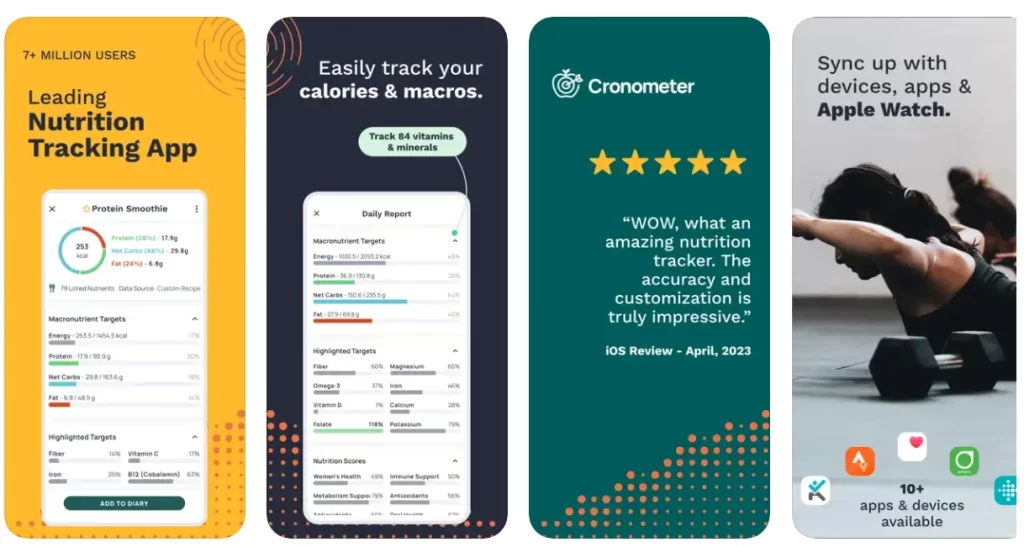
Cronometer stands out by offering easy tracking of calories and micro- and macronutrients, aiming to encourage healthier eating habits. Users can personalize settings, track single nutrients, and receive suggestions to improve their diet. The app verifies food submissions for accuracy, includes a free barcode scanner, and integrates with other fitness tracking apps. While there’s a pro version for healthcare providers, the free version is highly rated, and upgrading to the Gold subscription offers ad-free use, custom charts, and fasting timers.
5. Noom
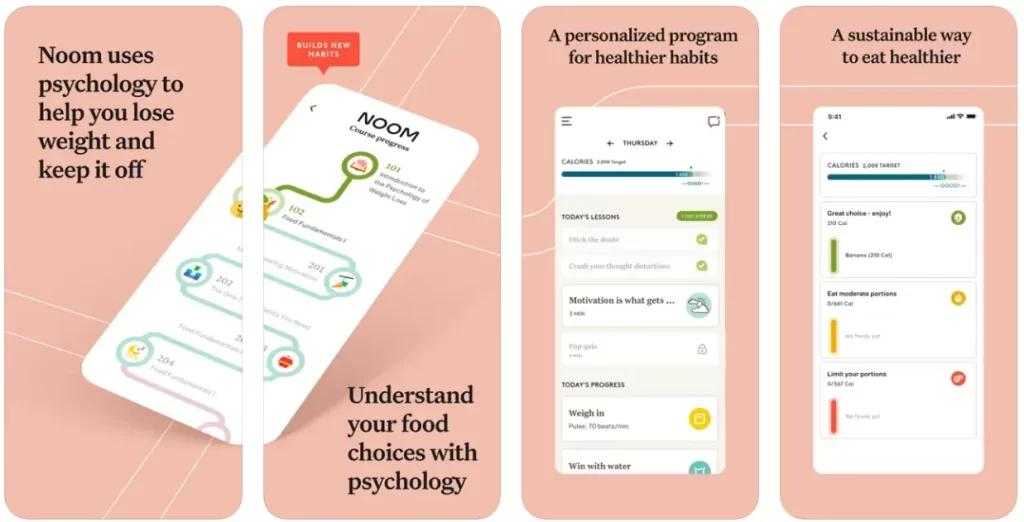
Noom focuses on mindfulness and behavior modification related to eating decisions and overall health. The app employs quizzes, questionnaires, food, and activity tracking to delve into users’ eating habits. A health coach guides individuals towards specific goals through a personalized plan, offering advice and support. Noom uses a “traffic light” food color system, categorizing foods based on calorie density. The app is downloadable for free, but it requires a fee for full functionality, making it pricier compared to other options on the list.
Tech Stack To Consider To Develop A Personalized Nutrition Guide App
Developing a personalized nutrition guide app involves a combination of technologies to handle various aspects such as data processing, user interface, and backend infrastructure. Here is a tech stack that you might consider for building such an app:
1. Programming Languages
Frontend: JavaScript (React or Angular for web, React Native or Flutter for mobile)
Backend: Python (Django or Flask), Node.js, or Java
2. Database
SQL Databases: PostgreSQL or MySQL for structured data
NoSQL Databases: MongoDB for unstructured or semi-structured data
3. Server-Side Development
Framework: Flask or Django for Python, Express.js for Node.js
Authentication: OAuth for third-party logins, JWT (JSON Web Tokens) for secure communication
4. APIs and Integrations
Nutritional Data APIs: Consider using APIs like Nutritionix or Edamam for food and nutrition data
Payment Integration: If your app involves premium features, consider integrating payment gateways like Stripe or PayPal.
5. Cloud Services
Hosting: AWS, Google Cloud Platform, or Microsoft Azure
Serverless Architecture: AWS Lambda or Google Cloud Functions for handling specific tasks without managing servers
6. Machine Learning / AI
Recommendation Engine: Use machine learning algorithms to provide personalized nutrition recommendations. Python libraries like TensorFlow or PyTorch can be useful.
7. Data Storage and Processing
Data Storage: Amazon S3 or Google Cloud Storage for storing user data and media files
Data Analysis: Pandas and NumPy for data manipulation and analysis.
Processing: Apache Spark or Apache Flink for large-scale data processing
8. Frontend Libraries and Frameworks
UI Framework: React, Angular, or Vue.js for a responsive and interactive user interface
State Management: Redux (for React), Vuex (for Vue), or Angular services
9. Mobile App Development
If you plan to have a mobile app, you can use frameworks like React Native or Flutter for cross-platform development.
10. Security
Implement HTTPS for secure communication
Regular security audits and penetration testing
11. Testing
Unit Testing: Jest for JavaScript, PyTest for Python
Integration Testing: Selenium or Cypress for end-to-end testing
12. Version Control
Git for version control, hosted on platforms like GitHub or GitLab.
13. Containerization and Orchestration
Docker for containerization, Kubernetes for orchestration.
14. Monitoring and Logging
Use tools like Prometheus for monitoring and ELK (Elasticsearch, Logstash, Kibana) stack for logging.
15. Documentation
Use tools like Swagger or ReDoc for API documentation.
16. Continuous Integration/Continuous Deployment (CI/CD)
Jenkins, GitLab CI, or GitHub Actions for automating the build and deployment process.
Conclusion
The development of personalized nutrition guide apps for both Android and iOS platforms represents a significant opportunity to contribute to the overall well-being of individuals. These apps serve as powerful tools for users to take control of their health by offering features such as food tracking, calorie counting, and customized nutritional plans.
The rising interest in wellness and health apps signifies a growing market that investors can tap into. As the demand for such applications continues to surge, companies that prioritize effective strategies and engagement methods for marketing their nutrition and diet apps are better positioned to help users achieve their health objectives.
As the health and wellness trend continues to gain momentum, personalized nutrition guide apps represent a powerful tool in promoting positive lifestyle changes and contributing to improving public health.
How Idea Usher Can Help With Developing A Personalized Nutrition Guide App?
Choosing the right partner for developing a personalized nutrition guide app is crucial for ensuring its success, and Idea Usher stands out as an innovative healthcare app development company that can meet your specific needs. Here’s why selecting Idea Usher is the best option for your nutrition app development project:
1. Experienced Nutrition App Developers
At Idea Usher, we boast a team of experienced nutrition app developers who understand the intricacies of creating apps that cater to the unique requirements of users. Our developers are adept at crafting solutions that prioritize user experience, ensuring that your nutrition app is both user-friendly and effective in promoting healthy lifestyles.
2. Technical Expertise and Seamless Integration
As technical experts, we at Idea Usher offer seamless integration of cutting-edge technologies into your nutrition app. Whether it’s incorporating features like food tracking, calorie counting, or advanced personalization using AI algorithms, our technical prowess ensures that your app is equipped with the latest innovations in the healthcare and wellness space.
3. Client Confidentiality and Integrity
We understand the importance of maintaining client confidentiality and upholding the highest standards of integrity. Idea Usher prioritizes the security and privacy of your project, implementing robust measures to safeguard sensitive information throughout the development process. Our commitment to client trust ensures a secure and confidential collaboration.
4. Comprehensive Project Management and Support
Idea Usher goes beyond development by providing comprehensive project management and ongoing support throughout the development lifecycle. From conceptualization to deployment and beyond, our team is dedicated to ensuring a smooth and successful development process. We collaborate closely with clients, keeping them informed and involved at every stage, fostering a transparent and communicative partnership.
You can read a case study about RBT – Radical Body Transformations, a fitness app we have developed for our client, though which you can gain an idea about our expertise in the health and fitness app development industry
Contact us today to know more about how we can help you with our app development services.
FAQ
Q. How to create a diet and nutrition guide app?
A. Creating a diet and nutrition app involves several key steps. Firstly, define the app’s purpose and target audience. Conduct thorough market research to understand user needs and preferences. Next, outline the app’s features, such as a food database, meal tracking, and personalized recommendations. Collaborate with nutritionists or dietitians to ensure the app’s accuracy and reliability. Choose a development platform and technology stack, considering factors like scalability and user experience. Design an intuitive and appealing user interface. Finally, test the app extensively for functionality, security, and user experience before launching it on app stores.
Q. How much does it cost to make a nutrition guide app?
A. The cost of developing a nutrition app varies based on factors like features, complexity, platform, and location of the development team. It’s crucial to consider ongoing maintenance and updates in your budget. Hiring developers from different regions may affect costs, with developers in Western countries generally charging higher rates than those in Eastern countries.
Q. How do nutrition guide apps make money?
A. Nutrition guide apps employ various monetization strategies to generate revenue. The most common methods include freemium models, where the app is free to download but offers premium features through in-app purchases or subscription plans. Advertisements within the app, sponsored content, and partnerships with food or wellness brands are other revenue streams. Some apps also collaborate with healthcare providers or employers, offering corporate wellness programs or integrating with employee benefit packages for a fee.
Q. Are fitness guide apps profitable?
A. Fitness apps can be profitable, given the growing interest in health and wellness. Success depends on factors such as app quality, unique features, marketing strategy, and user engagement. Apps offering personalized workout plans, progress tracking, and social features tend to attract and retain users. Monetization through subscription models, one-time purchases, or partnerships with fitness equipment brands can contribute to profitability. A well-designed app with a clear value proposition and effective marketing can tap into the lucrative fitness market and yield sustainable profits.










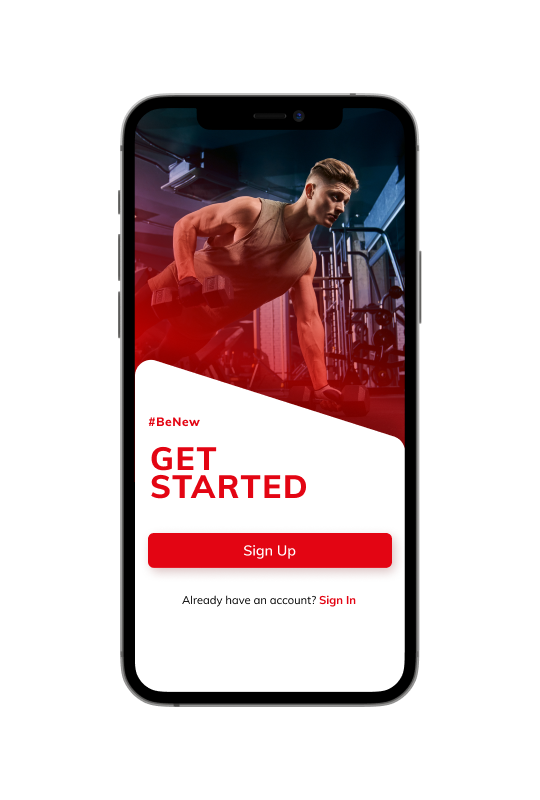


Gaurav Patil